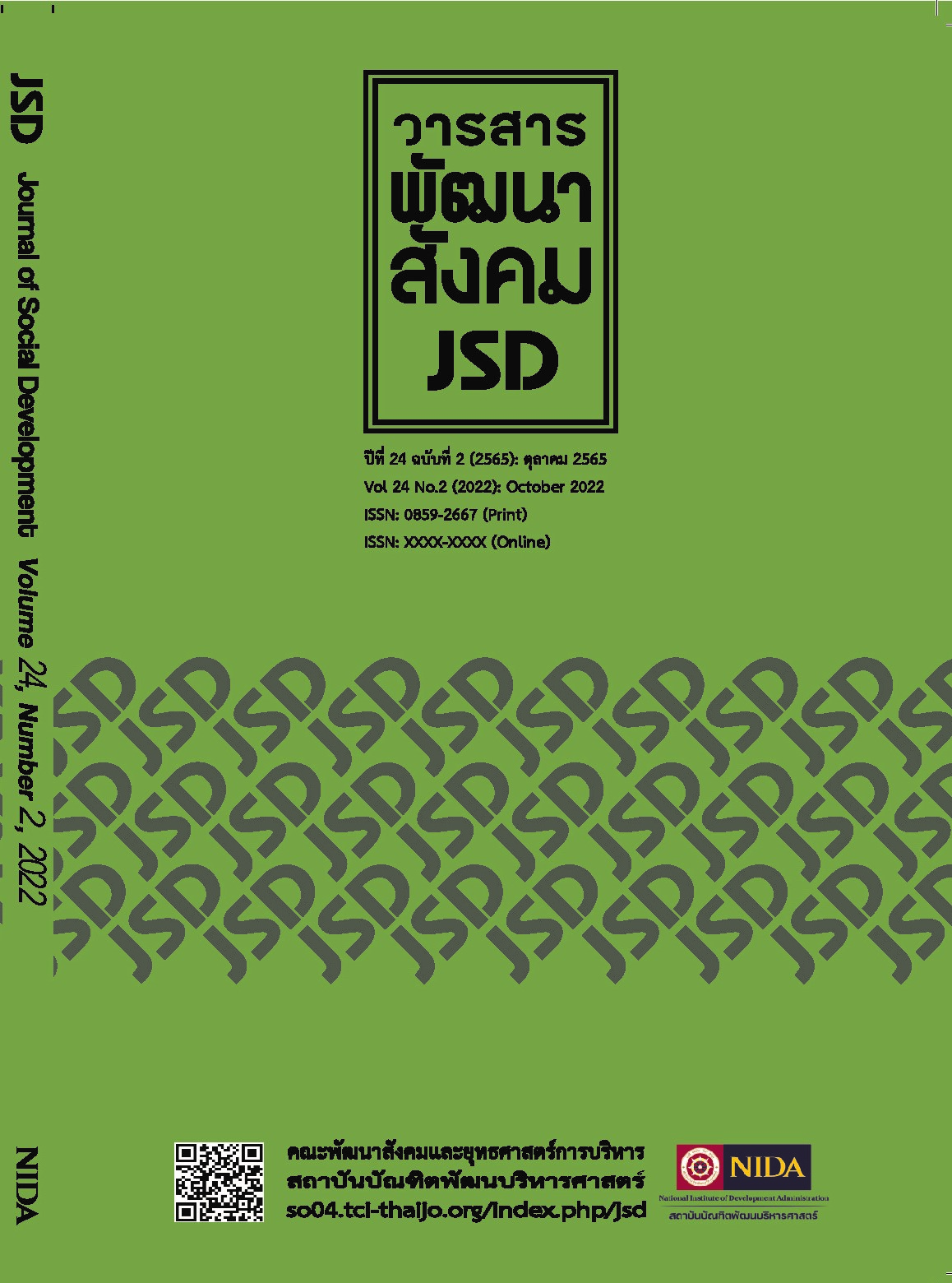Development and Validation of Bystander’s Emotionally Supportive Behavior Scale in Junior High School Students
Main Article Content
Abstract
This study aimed at constructing and validating of emotionally supportive behavior scale of bystander to bullying in school. The objectives were to investigate the dimensions and validity of this construct. Total samples were 703 junior high school students in Bangkok. By performing exploratory factor analysis using data set 1, three dimensions were emerged from EFA with the total of 10 items. These dimensions were
1) acceptance of bullying (total of 4 items), 2) ignoring situations that lead to bullying (total of 4 items), and 3) empathy for victim (total of 2 items). These three dimensions could explain the variance of ESBBS with 61.646%. Data set 2 were employed in confirmatory factor analysis. The EFA measurement model was confirmed. By using data set 3, the newly constructed measure was validated and positively related to the standardized psychological and behavioral measures. Thus, this new scale can confidently be used in future studies and assessment in order to increase helping behaviors relating to bullying.
Article Details

This work is licensed under a Creative Commons Attribution-NonCommercial-NoDerivatives 4.0 International License.
References
Bhanthumnavin, D. (1995). Ethical tree theory: Personnel research and Development [In Thai]. Bangkok: National Institute of Development Administration.
Bhanthumnavin, D. (2000). Importance of Supervisory Social Support and Its Implications for HRD in Thailand. Psychology and Developing Societies: A Journal, 12(2), 155-166.
Cobb, S. (1976). Social support as a moderator of life stress. Psychosomatic Medicine, 38(5),
–314. https://doi.org/10.1097/00006842-197609000-00003.
Constantine, M. G., & Ponterotto, J. G. (2006). Evaluating and selecting psychological measures for research purposes. The psychology research handbook: A guide for graduate students and research assistants (pp.104-114). Thousand Oaks: SAGE Publications.
Craig, W., Harel-Fisch, Y., Fogel-Grinvald, H., Dostaler, S., Hetland, J., Simons-Morton, B., ... & Pickett, W. (2009). A cross-national profile of bullying and victimization among
adolescents in 40 countries. International Journal of Public Health, 54(2), 216-224.
Demaray, K. & Malecki, K. (2003). Perceptions of the frequency and importance of social support by students classified as victims,bullies, and bully/victims in an urban middle school. Journal of SchoolPsychology Review, 32(3), 471-489.
Duanginta, Y. (2006). Research - based construction of future orientation self control measure for college students [In Thai]. National Institute of Development Administration.
Field, A. (2000). Discovering statistics using spss for windows. London-Thousand Oaks-New Delhi: Sage publications.
George, D., & Mallery, M. (2010). SPSS for Windows Step by Step: A Simple Guide and Reference, 17.0 update (10th ed.). Boston: Allyn & Bacon.
Hair, J.F., Black, W.C., Babin, B.J. & Anderson, R.E. (2010) Multivariate Data Analysis. 7th Edition, Pearson, New York.
Heinrichs, R. (2003). A whole - school approach to bullying: Special considerations for children with exceptionalities. Intervention in School & Clinic, 38(4), 195-204.
Judge T. A., Locke E. A., & Durham C. C. (1997). The dispositional cause of job satisfaction: A core evaluations approach. Research in Organizational Behavior, 19, 151-188.
Judge T. A., Erez, A., Bono, J. E., & Thoresen, C. J. (2003). The Core Self-Evaluation Scale: Development of a measure. Personnel Psychology, 56(2), 303-331.
Kerlinger, F. N., & Lee, H. B. (2000). Foundations of behavioral research. Fort Worth, TX: Harcourt College Publishers.
Kline, R.B. (2010). Principles and Practice of Structural Equation Modeling. New York: The Guilford Press.
Laeheem, K. (2013). Bullying behavior of students [In Thai]. Songkhla: Faculty of Science, Prince of Songkla University.
Olweus, D. (1993). Bullying at school: what we know and what we can do. Oxford, UK: Blackwell.
Pathomsirikul, P. (2012). Psychosocial Factors Related to Efficient Work Behavior of Purchasing Officer of Thai Food and Instant Food Manufacturing Group (Master’ thesis). Srinakharinwirot University, Bangkok.
Peets, K., Pöyhönen, V., Juvonen, J., & Salmivalli, C. (2015). Classroom norms of bullying alter the degree to which children defend in response to their affective empathy and power. Developmental Psychology, 51(7), 913-920.
Phramaha jundham inteekred. (2009). The relations of psychological characteristics and social situation to wards work efficiency of rescue volunteers from Ruamkatanyu foundation in Bangkok (Master’s thesis). Srinakharinwirot University, Bangkok.
Rotter, J. B. (1966). Generalized expectancies for internal versus external control of reinforcement. Psychological Monographs, 80(1), 1-28.
Sakarinkhul, C. & Wacharasindhu, A. (2014). Prevalence of Bullying and Associated Psychosocial Factors among Lower Secondary School Students in Muang, Chiangmai [In Thai]. Journal of the Psychiatric Association of Thailand, 59(3), 221-230.
Salmivalli, C., Lagerspetz, K., Björkqvist, K.,Österman, K., & Kaukiainen, A. (1996). Bullying as a group process: Participant roles and their relations to social status within the group. Aggressive Behavior, 22(1), 1-15.
Sanamkate, T. & Bhanthumnavin, D. (2016). Psychological Characteristics, Internal and External Familial Conditions as correlate of Perceived Appropriated Child-Rearing Practices in Thai Junior Highschool Students [In Thai]. Journal of Behavioral Science for Development, 8(1), 169-185.
Summers, K., & Demaray, M. K. (2008). Bullying Participant Behaviors
Questionnaire. DeKalb, IL: Northern Illinois University.
Tapanya, S. (2006). Bullying among Thailand school student [In Thai]. Chiang Mai: Chiang Mai University.
Tiawilai, Y. (2018). The Psycho-social Factors Correlates of Moral Communications Behavior Focusing on Social Media of Undergraduate Students (Master’s thesis). National Institute of Development Administration, Bangkok.
Wiratchai, N. (1994). Linear Structural Relationship (LISREL) Statistical Analysis for Social Sciences and Behavioral Science Research [In Thai]. Bangkok: Chulalongkorn University Press.
Yaemyuean, A. (2014). Research for Development and Assessment on Facebook Interpersonal Safety Behavior Instruments and Real Situations of Undergraduate Students and Measurement Invariance (Doctoral dissertation). National Institute of Development Administration, Bangkok.
Yaemyuean, A. (2014). Construction and Validation of Peer Safety Exchange Behavior Scale in Undergraduate Students and Its Measurement Invariance. Journal of Social Development, 16(2), 21-46.
Ziegler, M. (2014). Stop and State Your Intentions!: Let’s not forget the ABC of test construction. European Journal of Psychological Assessment, 30(4), 239-242. doi:10.1027/1015-5759/a000228
Ziegler, M. (2020). Psychological Test Adaptation and Development – A New Beginning. Psychological Test Adaptation and Development, 0(0), 1-2. doi:10.1027/2698-1866/a000001


